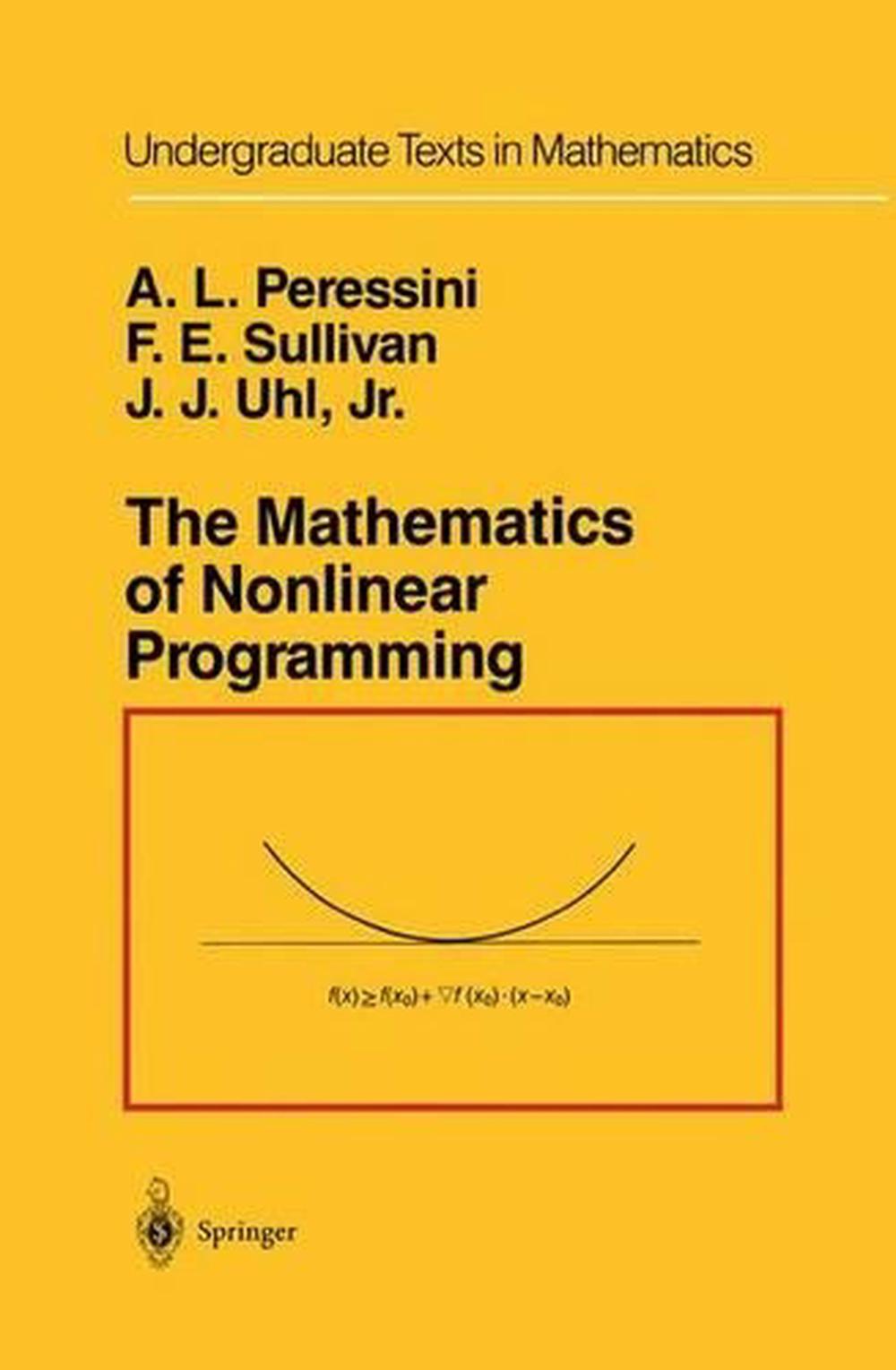
When you click on links to various merchants on this site and make a purchase, this can result in this site earning a commission. Affiliate programs and affiliations include, but are not limited to, the eBay Partner Network.
The Mathematics of Nonlinear Programming by Anthony L. Peressini (English) Hardc

- Item No : 146626064035
- Condition : Brand New
- Brand : No brand Info
- Seller : the_nile
- Current Bid : US $84.22
-
* Item Description
-
The Nile on eBay

The Mathematics of Nonlinear Programming
by Anthony L. Peressini, Francis E. Sullivan, J.J. Uhl, Jr., J.J. Uhl
Nonlinear programming provides an excellent opportunity to explore an interesting variety of pure and solidly applicable mathematics, numerical analysis, and computing. This text develops some of the ideas and techniques involved in the optimization methods using calculus, leading to the study of convexity.
FORMAT
HardcoverLANGUAGE
EnglishCONDITION
Brand New
Publisher Description
Nonlinear programming provides an excellent opportunity to explore an interesting variety of pure and solidly applicable mathematics, numerical analysis, and computing. This text develops some of the ideas and techniques involved in the optimization methods using calculus, leading to the study of convexity. This is followed by material on basic numerical methods, least squares, the Karush-Kuhn-Tucker theorem, penalty functions, and Lagrange multipliers. The authors have aimed their presentation at the student who has a working knowledge of matrix algebra and advanced calculus, but has had no previous exposure to optimization.
Notes
The book is aimed at students who have a working knowledge of linear algebra and partial differentiation but has had no previous exposure to optimization. Mathematics instructors will be comfortable with the mathematical approach which deemphasizes recipes and emphasizes underlying concepts. There are many exercises chosen to highlight the fundamental ideas.
Table of Contents
1 Unconstrained Optimization via Calculus.- 1.1. Functions of One Variable.- 1.2. Functions of Several Variables.- 1.3. Positive and Negative Definite Matrices and Optimization.- 1.4. Coercive Functions and Global Minimizers.- 1.5. Eigenvalues and Positive Definite Matrices.- Exercises.- 2 Convex Sets and Convex Functions.- 2.1. Convex Sets.- 2.2. Some Illustrations of Convex Sets in Economics— Linear Production Models.- 2.3. Convex Functions.- 2.4. Convexity and the Arithmetic-Geometric Mean Inequality— An Introduction to Geometric Programming.- 2.5. Unconstrained Geometric Programming.- 2.6. Convexity and Other Inequalities.- Exercises.- 3 Iterative Methods for Unconstrained Optimization.- 3.1. Newton's Method.- 3.2. The Method of Steepest Descent.- 3.3. Beyond Steepest Descent.- 3.4. Broyden's Method.- 3.5. Secant Methods for Minimization.- Exercises.- 4 Least Squares Optimization.- 4.1. Least Squares Fit.- 4.2. Subspaces and Projections.- 4.3. Minimum Norm Solutions of Underdetermined Linear Systems.- 4.4. Generalized Inner Products and Norms; The Portfolio Problem.- Exercises.- 5 Convex Programming and the Karush-Kuhn-Tucker Conditions.- 5.1. Separation and Support Theorems for Convex Sets.- 5.2. Convex Programming; The Karush-Kuhn-Tucker Theorem.- 5.3. The Karush-Kuhn-Tucker Theorem and Constrained Geometric Programming.- 5.4. Dual Convex Programs.- 5.5. Trust Regions.- Exercises.- 6 Penalty Methods.- 6.1. Penalty Functions.- 6.2. The Penalty Method.- 6.3. Applications of the Penalty Function Method to Convex Programs.- Exercises.- 7 Optimization with Equality Constraints.- 7.1. Surfaces and Their Tangent Planes.- 7.2. Lagrange Multipliers and the Karush-Kuhn-Tucker Theorem for Mixed Constraints.- 7.3. Quadratic Programming.- Exercises.
Promotional
Springer Book Archives
Long Description
This book is designed for a first course in nonlinear optimization. It starts with classical optimization notions from calculus and proceeds smoothly to a study of convex functions. This is followed by material on basic numerical methods, least squares, Karush-Kuhn-Tucker theory, penalty functions, and Lagrange multipliers. The book has been tested in the classroom; the approach is rigorous at all times and geometric intuition is developed. The numerical methods are up-to-date. The presentation emphasizes the mathematical ideas behind computer codes.The book is aimed at the student who has a working knowledge of linear algebra and partial differentiation but has had no previous exposure to optimization. Mathematics instructors will be comfortable with the mathematical approach which deemphasizes recipes and emphasizes understanding underlying concepts. There are many exercises chosen to highlight the fundamental ideas.
Description for Sales People
The book is aimed at students who have a working knowledge of linear algebra and partial differentiation but has had no previous exposure to optimization. Mathematics instructors will be comfortable with the mathematical approach which deemphasizes recipes and emphasizes underlying concepts. There are many exercises chosen to highlight the fundamental ideas.
Details
ISBN0387966145Short Title MATHEMATICS OF NONLINEAR PROGRSeries Undergraduate Texts in MathematicsLanguage EnglishISBN-10 0387966145ISBN-13 9780387966144Media BookFormat HardcoverDEWEY 519.76Imprint Springer-Verlag New York Inc.Place of Publication New York, NYCountry of Publication United StatesPages 276DOI 10.1007/b36889;10.1007/978-1-4612-1025-2AU Release Date 1993-06-17NZ Release Date 1993-06-17UK Release Date 1993-06-17Author J.J. UhlPublisher Springer-Verlag New York Inc.Edition Description 1st ed. 1988. Corr. 2nd printing 1993Edition 1stAlternative 9781461269892Illustrations X, 276 p.Audience Professional & VocationalYear 1988Publication Date 1988-03-02US Release Date 1988-03-02


















